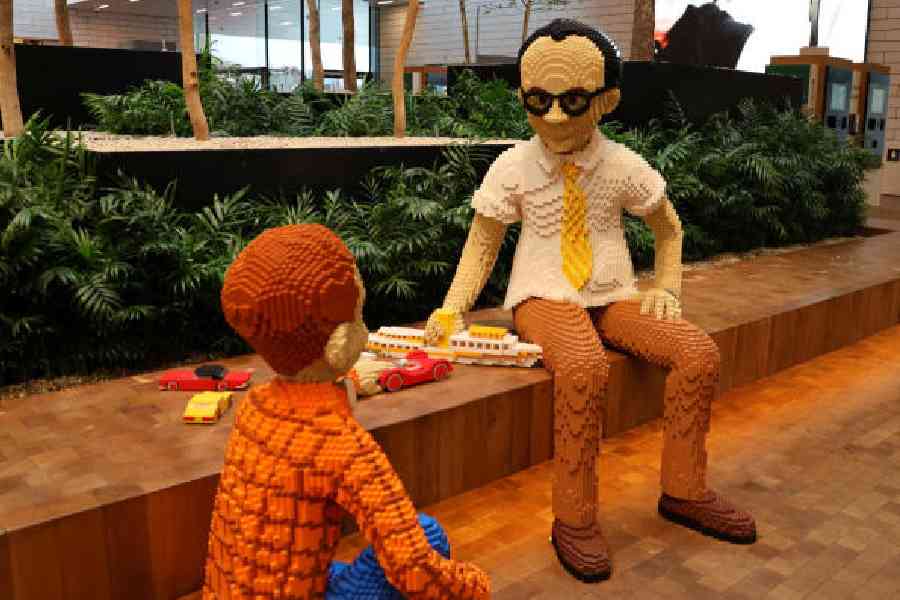On a miserable, drizzly day in late June, Hayley Hardstaff, a marine biologist, took a walk along Portwrinkle Beach in Cornwall, England, and discovered a dragon. It was a Lego piece — black, plastic and missing its upper jaw.
Hardstaff, who grew up in Cornwall, had a long history of finding Lego pieces. As a child there, she collected them from the beach, puzzled about why so many children were forgetting their toys.
By the time she went walking last June, she knew much more, and quickly recognised the scaly head and neck poking out of the sand, “its entire dragonhood on display”.
Hardstaff had found yet another tiny artefact of one of history’s oddest maritime mishaps.
In 1997, nearly five million Lego pieces — including 33,427 black dragons — were packed in a shipping container when a rogue wave hit the Tokio Express, a cargo ship hauling the toys and other goods. The ship, which had been travelling to New York from Rotterdam, the Netherlands, nearly capsized, and it lost all 62 of its shipping containers — an event known as the Great Lego Spill.
In a whimsical twist, many of the pieces were nautically themed. It was arguably the single largest toy-related environmental disaster that we know of, experts say, and people are still finding pieces 27 years later.
The event and its aftermath are documented on social media on the Lego Lost at Sea Facebook page, where Hardstaff learned the history. “I’d seen some people had found these dragons,” she said. “Otherwise, I would have had no idea.”
Lego Lost at Sea, which also has accounts on X and Instagram, is run by Tracey Williams, who started documenting Lego finds after she moved to Cornwall around 2010.
“The very first time I went to the beach, I found a bit of Lego from the spill, and I thought that was quite astonishing,” she said.
Williams knew the story of the Great Lego Spill. Years ago, during visits to her parents’ home in Devon, she regularly took her children beachcombing. They looked for shells, sea glass and interesting pebbles. Then, in 1997, Lego pieces started washing up.
“We knew it’s from a cargo spill, but I didn’t know much more about it,” she said, adding that her children would fill up small plastic buckets with their beach treasures.
“I hadn’t really forgotten about the Lego story,” she said, “but it was when I came here to Cornwall and saw it washing up again and I just thought, That’s astonishing, you know, that 13 years later and this Lego was still appearing.”
Her find sparked an idea: creating a community to trace who else had found Lego, which pieces they had found, and where. She created a Facebook page, and the BBC reported on it, leading to a flood of submissions.
People found tiny, colourful octopuses, dragons, life rafts, scuba flippers, scuba tanks, sea grass and more, and they enthusiastically reported their finds to the page. “At last,” read a blurb from a recent find, “after years of searching I find my very first piece of lego, lost at sea.” The endeavor became a widely followed project and lead to a book titled “Adrift: The Curious Tale of the Lego Lost at Sea.”
Over the years, Williams has kept a record of the found pieces, including rare green dragons (only 514 were in the container) and black octopuses (4,200) that have become prized finds for beachcombers. She’s mapped where the toys have turned up — on the English coast, in Wales, France, Belgium, Ireland and the Netherlands. But it’s possible pieces have drifted all over the world by now.
For Curtis Ebbesmeyer, there’s no doubt about it. Ebbesmeyer is an oceanographer known for tracking the Friendly Floatees Spill in 1992, in which thousands of rubber ducks and other bath toys washed into the Pacific Ocean. He said ocean currents were “like the world’s greatest subway line”.
“They take anything, anywhere,” he said.
After the Cornwall spill, Ebbesmeyer reached out to Lego to ask what had been on the ship. The company sent him an inventory, along with a sampling of the kinds of pieces that had been in the container. He promptly tested them in his bathtub for buoyancy and found that half of the pieces floated.
That difference could account for the missing Lego pieces that fell off the Tokio Express in 1997 and have yet to surface. Williams said she regularly spoke to fishermen who discovered the pieces as they trawled the bottom of the ocean. A Lego shark, one of 51,800 that were in the container, was caught in a fisherman’s net 20 miles off the Cornish coast in late July. It’s the first of the sharks to see daylight in 27 years.
“Only another 51,799 to find,” Williams wrote on the Lego Lost at Sea account.
New York Times News Service











